Stability Monitoring and Numerical Simulation of Weathering Transition Zones in Dam Slopes of Tropical Islands
Abstract
1. Introduction
2. Methods
2.1. Project Background and Engineering Geology
2.2. Similarity Theory and Materials
2.3. Experimental Instrument
2.4. Model Test Process
- (1)
- To simulate the natural fracture networks and joint set development in the dam slope, the stratified compaction and prefabricated block stacking method was used to simulate original stratigraphic deposition sequences (Figure 5). The weakly weathering zone and fully weathering zone were constructed by layer-compacting (dip angle: 50°, thickness: 2.0 cm), and the mica sheet was used to simulate interlayer structural planes. Prefabricated rock block (size: 2.5 × 2.5 × 2.0 cm) was used to simulate broken rock blocks in the strongly weathering zone. The similar material of the fully weathering zone was used to bond the rock blocks and fill the slope surface to meet the principle of fracture seepage advantage.
- (2)
- In the experiment, the gradient-enhanced wind and rainfall intensity were used to simulate the cyclonic rainfall environment. After reaching maximum wind and rainfall intensities, the groundwater diversion device was used to simulate the groundwater dynamic field. Referring to commonly used rainfall intensity determination methods [19], rainfall intensities of 35, 65, and 105 mm/h were adopted according to the historical rainfall data from the engineering region. Wind loading conditions were designed based on the wind speed similarity ratio. The test loading scheme is shown in Table 4. Four loading stages were used to simulate rainfall generation, rainfall intensification, and hydraulic fluctuation caused by cyclonic rainfall.
3. Results and Discussion
3.1. Pore Water Pressure Evolution of Weathering Transition Zone
3.2. ITS Response of Slope Anchorage System
3.3. Weathering Transition Zone Stability Monitoring Criterion
- (1)
- In this study, artificial porous media materials were used to simulate the real geological body. However, it is impossible to realize that all physical parameters satisfy the similarity laws in the material research, which results in differences between the deformation characteristics of the model slope and the prototype.
- (2)
- The similarity ratio of rainfall time was not considered, and the hydraulic effect caused by rainfall infiltration and groundwater fluctuation may not reflect the real situation [37]. In addition, the distribution of the effective stress field is different from that of the prototype slope, so the failure process of the real slope cannot be fully simulated.
- (3)
- A large number of studies have shown that the effective stress level is an important factor affecting the slope failure mode [38,39]. Since the distribution of the effective stress field in the model test is different from that of the real situation, the failure mode of the prototype slope cannot be accurately simulated.
- (4)
- The slope stability monitoring criterion obtained in the model test essentially uses the slope deformation to feedback on the hydraulic failure of the weathering transition zone. Considering the defects of the 1-g model, the monitoring criterion obtained from the physical model test cannot characterize the evolution laws between all monitoring points.
3.4. Numerical Simulation Analysis
3.4.1. Model Construction
3.4.2. Calculation Results
3.4.3. Monitoring Point Data Analysis
4. Conclusions
- (1)
- Physical model test results showed that pore water pressure in the weathering transition zone during the rainfall infiltration stage was positively correlated with rainfall intensity, and pore water pressure increased significantly during the hydraulic fluctuation stage. The increase of permeability caused by hydraulic fluctuation and the expansion of the rock fracture network are the main causes for the increase of lateral deformation of the slope. The numerical simulation results showed that rainfall infiltration increased the pore water pressure in the shallow layer, the hydraulic effect of the structural plane increased the deep pore water pressure, and the strain softening caused by the decrease of effective stress is the main reason for the increase of slope displacement.
- (2)
- The physical model test results showed that during the rainfall infiltration stage, splash erosion and runoff led to rapid loss of anchor bolt preload in the middle and lower parts of the strongly weathering zone. With the increase of self-weight stress, tension cracks occurred at the top of the slope, and the axial force of the anchor bolt near the top of the slope increased. During the stage of hydraulic fluctuation, anchor bolt axial force decreased first, then increased, and finally tended to stabilize. ITS unloading response was observed at some monitoring points. In the numerical simulation, the axial force of the bolt increased continuously with the lateral displacement of the slope.
- (3)
- Based on the results of the physical model test and numerical simulation, the evolution laws of bolt axial force and pore water pressure in the weathering transition zone were analyzed, and a stability monitoring criterion of the slope weathering transition zone based on the Logistic function was established. In view of the long-term monitoring of bolt axial force as a common technique for slope disaster prevention, the monitoring criterion proposed in this study provides a useful reference for slope disaster prevention under cyclonic rainfall.
- (4)
- In this study, the physical model test was carried out under 1-g condition, making it very difficult to simulate the effective stress field distribution of the prototype slope. Therefore, the obtained slope failure mode is different from the real situation. Centrifuge model tests should be carried out in the future to obtain more accurate slope failure modes and weathering transition zone stability monitoring criteria.
Author Contributions
Funding
Institutional Review Board Statement
Informed Consent Statement
Data Availability Statement
Conflicts of Interest
References
- Choy, C.-W.; Wu, M.-C.; Lee, T.-C. Assessment of the damages and direct economic loss in Hong Kong due to Super Typhoon Mangkhut in 2018. Trop. Cyclone Res. Rev. 2020, 9, 193–205. [Google Scholar] [CrossRef]
- Yun, X.; Zhang, Y.; Liang, D.; Qu, Y.; Chen, H. Granite thermal reservoirs in Lingshui area of Hainan Island and their significance to geothermal resources, China. Energy Geosci. 2023, 4, 100166. [Google Scholar] [CrossRef]
- Chen, Z. Petrostratigraphy in Hainan Province; China University of Geosciences Press: Wuhan, China, 1997. (In Chinese) [Google Scholar]
- Luo, S.L.; Huang, D.; Peng, J.B.; Tomás, R. Influence of permeability on the stability of dual-structure landslide with different deposit-bedding interface morphology: The case of the three Gorges Reservoir area, China. Eng. Geol. 2022, 296, 106480. [Google Scholar] [CrossRef]
- Greco, R.; Comegna, L.; Damiano, E.; Marino, P.; Olivares, L.; Santonastaso, G.F. Recurrent rainfall-induced landslides on the slopes with pyroclastic cover of Partenio Mountains (Campania, Italy): Comparison of 1999 and 2019 events. Eng. Geol. 2021, 288, 106160. [Google Scholar] [CrossRef]
- Dou, H.; Xie, S.; Jian, W.; Wang, H.; Guo, C. Characteristics of preferential flow suffosion of soil-rock interface in spherical weathered granite slopes. Rock Soil Mech. 2024, 45, 950–960. (In Chinese) [Google Scholar] [CrossRef]
- He, M. Real-time remote monitoring and forecasting system for geological disasters of landslides and its engineering application. Chin. J. Rock Mech. Eng. 2009, 28, 1081–1090. (In Chinese) [Google Scholar]
- Zhou, Y.; Wang, X.; Zhu, Y.; Li, J.; Jiang, X. Monitoring and numerical simulation of an interbedding high slope composed of soft and hard strong-weathered rock. Rock Soil Mech. 2018, 39, 2249–2258. (In Chinese) [Google Scholar]
- Meng, Z.; Sun, H.; Zhu, Y.; Fu, B.; Ye, Z. Intelligent terminal structure response on anchorage foundation stability of Undersea Data Cabins affected by turbidity flow. Phys. Fluids 2025, 37, 025112. [Google Scholar] [CrossRef]
- Zerradi, Y.; Souissi, M.; Larabi, A. Application of the deterministic block theory to the slope stability design of an open-pit mine in Morocco. Min. Miner. Depos. 2023, 17, 53–60. [Google Scholar] [CrossRef]
- Sdvyzhkova, O.; Moldabayev, S.; Babets, D.; Bascetin, A.; Asylkhanova, G.; Nurmanova, A.; Prykhodko, V. Numerical modelling of the pit wall stability while optimizing its boundaries to ensure the ore mining completeness. Min. Miner. Depos. 2024, 18, 1–10. [Google Scholar] [CrossRef]
- Li, L.; Li, Y.; Xu, Y. Instability evolution of expansive soil slope due to short duration-varying intensities of rainfall. Eng. Fail. Anal. 2024, 161, 108313. [Google Scholar] [CrossRef]
- Chen, R.; Dou, H.; Lin, Y.; Liu, Q.; Jian, W. In-situ infiltration-runoff characterization of slopes under the influences of different rainfall patterns and slope gradients. Catena 2024, 247, 108519. [Google Scholar] [CrossRef]
- Song, X.; Tan, Y.; Lu, Y.; Liu, J.; Liu, Y. Experimental and numerical studies on the instability of simple homogeneous sandy slopes under different infiltration scenarios. Chin. J. Rock Mech. Eng. 2024, 43, 1204–1218. (In Chinese) [Google Scholar] [CrossRef]
- Zhuang, Y.; Xing, A.; Jiang, Y.; Sun, Q.; Yan, J.; Zhang, Y. Typhoon, rainfall and trees jointly cause landslides in coastal regions. Eng. Geol. 2022, 298, 106561. [Google Scholar] [CrossRef]
- Lin, B.; Zhang, D.; Jian, W.; Dou, H.; Wang, H.; Fan, X. Response of vegetated slope stability under wind-driven rain conditions. Rock Soil Mech. 2024, 45, 2765–2774. [Google Scholar] [CrossRef]
- Guo, Z.; Huang, Q.; Liu, Y.; Wang, Q.; Chen, Y. Model experimental study on the failure mechanisms of a loess-bedrock fill slope induced by rainfall. Eng. Geol. 2023, 313, 106979. [Google Scholar] [CrossRef]
- Li, X.; Li, Q.; Wang, Y.; Liu, W.; Hou, D.; Zhu, C. Effect of slope angle on fractured rock masses under combined influence of variable rainfall infiltration and excavation unloading. J. Rock Mech. Geotech. Eng. 2024, 16, 4154–4176. [Google Scholar] [CrossRef]
- Tao, Z.; Xu, C.; Liu, S.; Li, Y.; Xiu, K. Physical modelling of damage mechanism of slopes containing near horizontal weak layers under rainfall conditions. J. China Coal Soc. 2024, 49, 4671–4686. (In Chinese) [Google Scholar] [CrossRef]
- Li, K.; Sun, P.; Wang, H.; Ren, J. Insight into failure mechanisms of rainfall induced mudstone landslide controlled by structural planes: From laboratory experiments. Eng. Geol. 2024, 343, 107774. [Google Scholar] [CrossRef]
- Yu, D.; Huang, Q.; Kang, X.; Liu, Y.; Chen, X.; Xie, Q.; Guo, Z. The unsaturated seepage process and mechanism of internal interfaces in loess-filled slopes during intermittent rainfall. J. Hydrol. 2023, 619, 129317. [Google Scholar] [CrossRef]
- Zhu, Y.; Zhang, Y.; Lan, H.; Peng, J.; Zheng, H.; Zhao, D.; Yin, Y. Effect of crack depth on the initiation and propagation of crack-induced sliding in a paleosol area on a loess slope: Three-dimensional investigation based on model testing and laser scanning. Eng. Geol. 2024, 342, 107745. [Google Scholar] [CrossRef]
- Hu, H.; Huang, Y.; Xiong, M.; Zhao, L. Investigation of seismic behavior of slope reinforced by anchored pile structures using shaking table tests. Soil Dyn. Earthq. Eng. 2021, 150, 106900. [Google Scholar] [CrossRef]
- Zhao, D.-J.; Xu, H.-X.; Yu, Y.-B.; Chen, L.-S. Identification of synoptic patterns for extreme rainfall events associated with landfalling typhoons in China during 1960–2020. Adv. Clim. Change Res. 2022, 13, 651–665. [Google Scholar] [CrossRef]
- Sun, Q.; Zhang, T.; Wu, J.; Han, S.; Zhao, Y. Promoting effect of vegetation on the landslide induced by typhoon rainstorm. Geol. Surv. China 2022, 9, 66–73. (In Chinese) [Google Scholar] [CrossRef]
- Xu, B.; Liu, X.; Liang, Y.; Zhou, X.; Zhong, Z. Stability of bedded rock slopes subjected to hydro-fluctuation and associated strength deterioration. J. Rock Mech. Geotech. Eng. 2024, 16, 3233–3257. [Google Scholar] [CrossRef]
- Li, X. (Ed.) Experimental Simulation Technology of Rock Mechanics; Science Press: Beijing, China, 2007; pp. 16–24. [Google Scholar]
- Tao, Z.; Zhu, C.; He, M.; Karakus, M. A physical modeling-based study on the control mechanisms of Negative Poisson’s ratio anchor cable on the stratified toppling deformation of anti-inclined slopes. Int. J. Rock Mech. Min. Sci. 2021, 138, 104632. [Google Scholar] [CrossRef]
- Nian, G.Q.; Chen, Z.H.; Zhu, T.Y.; Zhang, L.F.; Zhou, Z.H. Experimental study on the failure of fractured rock slopes with anti-dip and strong weathering characteristics under rainfall conditions. Landslides 2024, 21, 165–182. [Google Scholar] [CrossRef]
- Tao, Z.; Ren, S.; Hao, Y.; Li, Q.; Fu, Q.; He, M. Physical model experiment on failure mechanism and NPR anchor cable control effect of layered counter-tilt slope. Rock Soil Mech. 2021, 42, 976–990. (In Chinese) [Google Scholar] [CrossRef]
- Zhu, Y.; Wang, A.; Huang, A.; Wu, L.; Cheng, D. Study on failure mechanism of loess slope reinforced by frame prestressed anchors under the action of rainfall. Met. Mine 2024, in press. Available online: https://kns.cnki.net/kcms/detail/34.1055.TD.20240605.1322.002.html (accessed on 15 April 2025). (In Chinese).
- Sun, H.; Liu, H.; Liu, X.L.; Ye, Z.N. Mechanical testing and numerical simulation of intelligent terminal structure of rockbolt used as a deformable support and for safety monitoring in rock engineering. Tunn. Undergr. Space Technol. 2024, 148, 105769. [Google Scholar] [CrossRef]
- Sun, H.; Liu, H.; You, C.; Ye, Z.; Long, Q. Yielding performance of an intelligent terminal structure for cable bolts. J. Intell. Constr. 2024, 2, 9180034. [Google Scholar] [CrossRef]
- Yuan, Z.; Yan, C.; Tao, Y.; Jia, Z.; Yang, W.; Xu, W.; Gao, S. Erosion model test of loess slope with framework protection. J. Eng. Geol. 2023, 31, 1989–1998. (In Chinese) [Google Scholar] [CrossRef]
- Takahashi, A.; Inoue, T.; Yamagata, S.; Horikoshi, K. Centrifuge model tests on suffusion-induced deterioration and its consequences in seismic response of levees. Soils Found. 2025, 65, 101592. [Google Scholar] [CrossRef]
- Zhao, X.; Song, X.; Wang, D.; Li, L.; Meng, P.; Fu, C.; Wang, L.; Wei, W.; Liu, Y.; Li, H. Mechanisms of hydraulic erosion control in different microrelief patterns of loess sloped farmland under continuous rainfall. Catena 2025, 249, 108630. [Google Scholar] [CrossRef]
- Garnier, J.; Gaudin, C.; Springman, S.M.; Culligan, P.J.; Goodings, D.; Konig, D.; Kutter, B.; Phillips, R.; Randolph, M.F.; Thorel, L. Catalogue of scaling laws and similitude questions in geotechnical centrifuge modelling. Int. J. Phys. Model. Geotech. 2007, 7, 1–23. [Google Scholar] [CrossRef]
- Xu, J.; Fang, K. Deformation characteristics of unsaturated slope during post-rainfall earthquake: Insights from centrifuge and numerical modeling. J. Rock Mech. Geotech. Eng. 2025, in press. [Google Scholar] [CrossRef]
- Xin, P.; Kang, X.; Wu, W.; Scaringi, G.; Wang, X.; Wu, Q. Centrifuge modelling of a roto-translational landslide in stiff clay formation. Eng. Geol. 2025, 349, 107964. [Google Scholar] [CrossRef]
- Fang, K.; Tang, H.; Li, C.; Su, X.; An, P.; Sun, S. Centrifuge modelling of landslides and landslide hazard mitigation: A review. Geosci. Front. 2023, 14, 101493. [Google Scholar] [CrossRef]
- Ng, C.W.W. The state-of-the-art centrifuge modelling of geotechnical problems at HKUST. J. Zhejiang Univ. Sci. A 2014, 15, 1–21. [Google Scholar] [CrossRef]
- Wang, Y.; Aryana, S.A.; Allen, M.B. An extension of Darcy’s law incorporating dynamic length scales. Adv. Water Resour. 2019, 129, 70–79. [Google Scholar] [CrossRef]
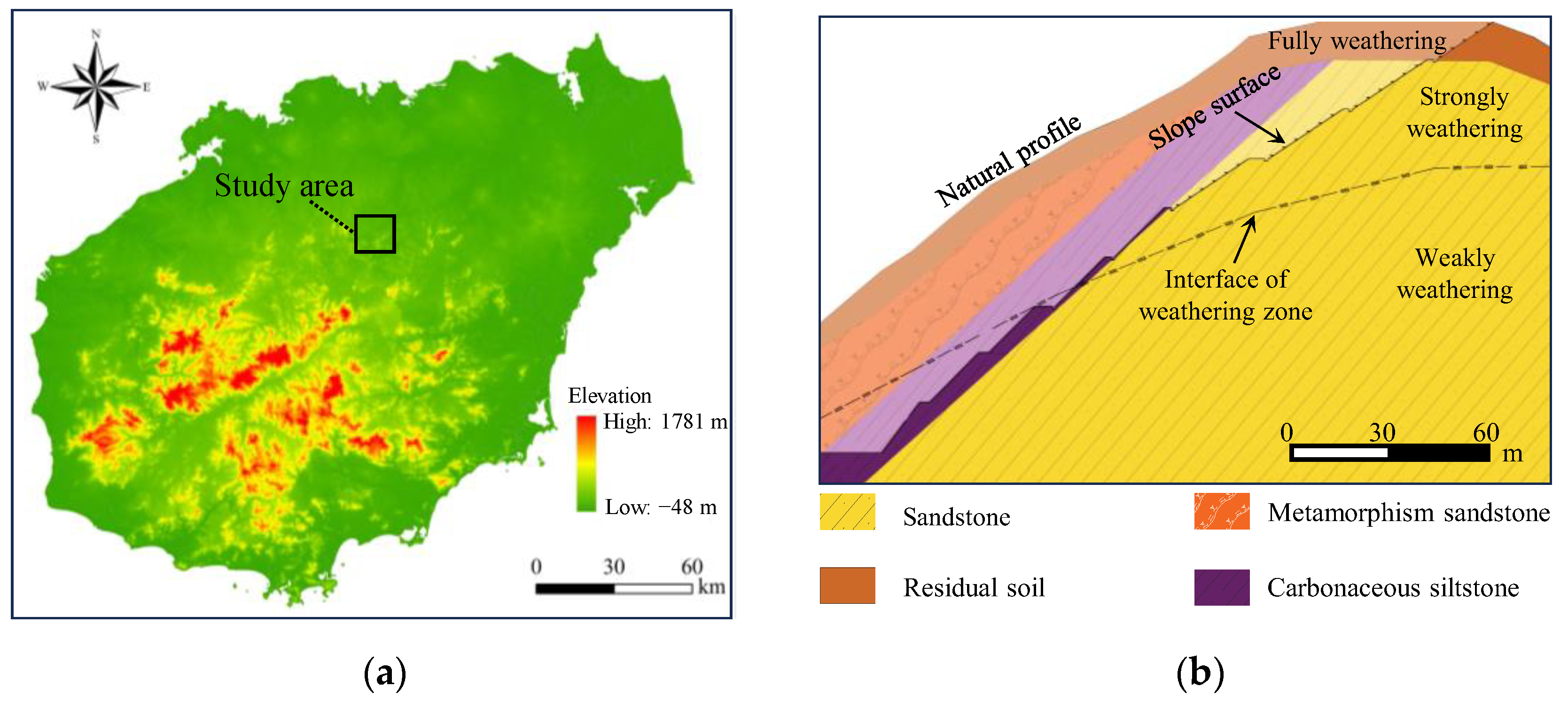
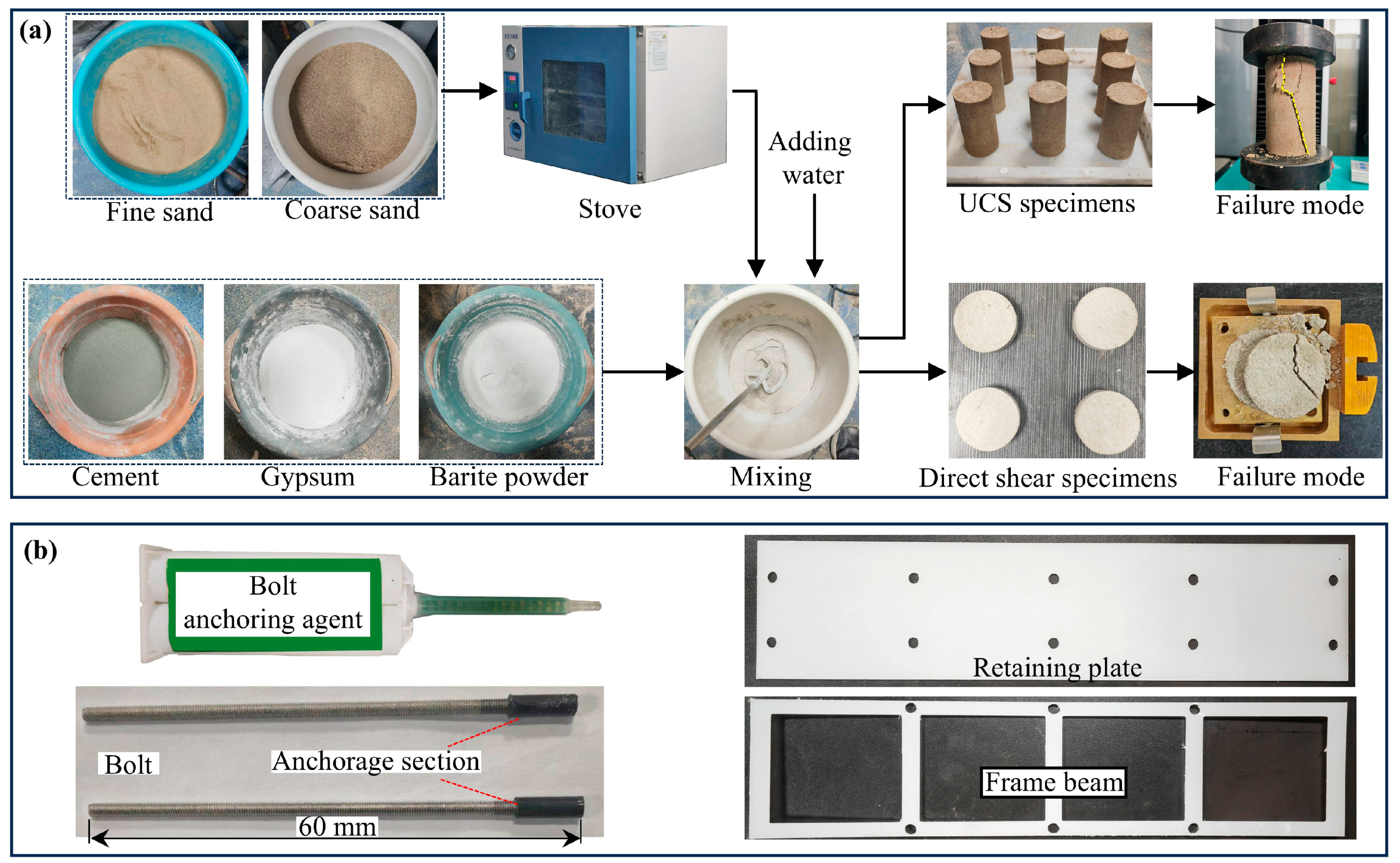
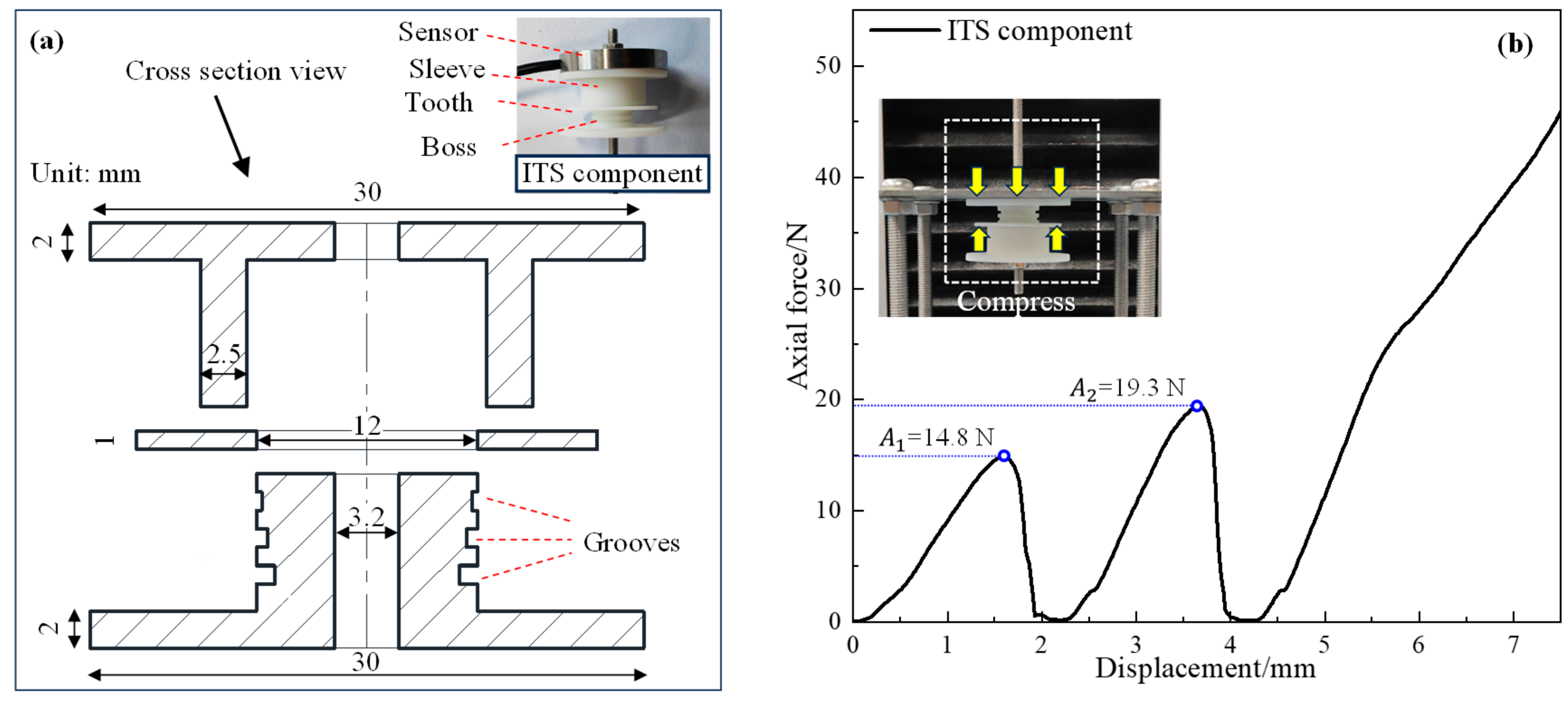
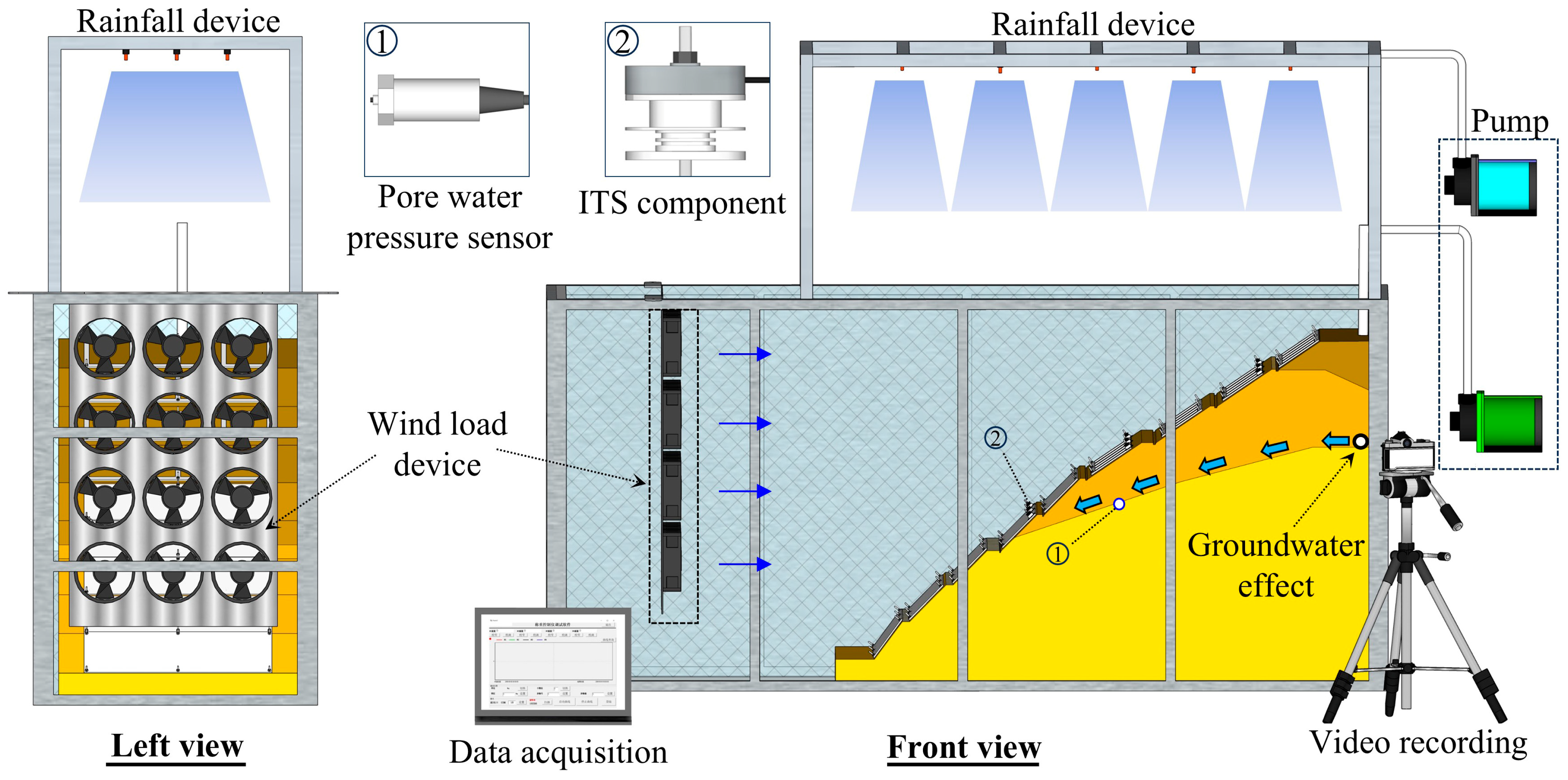
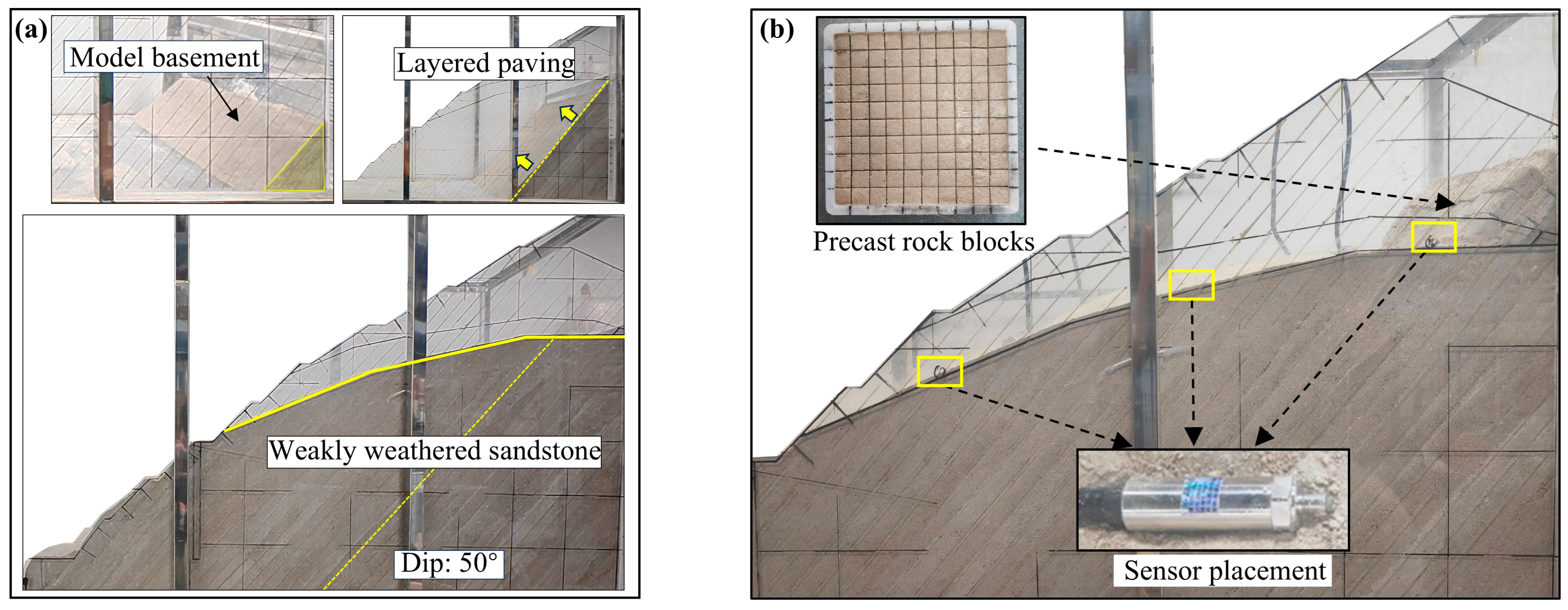
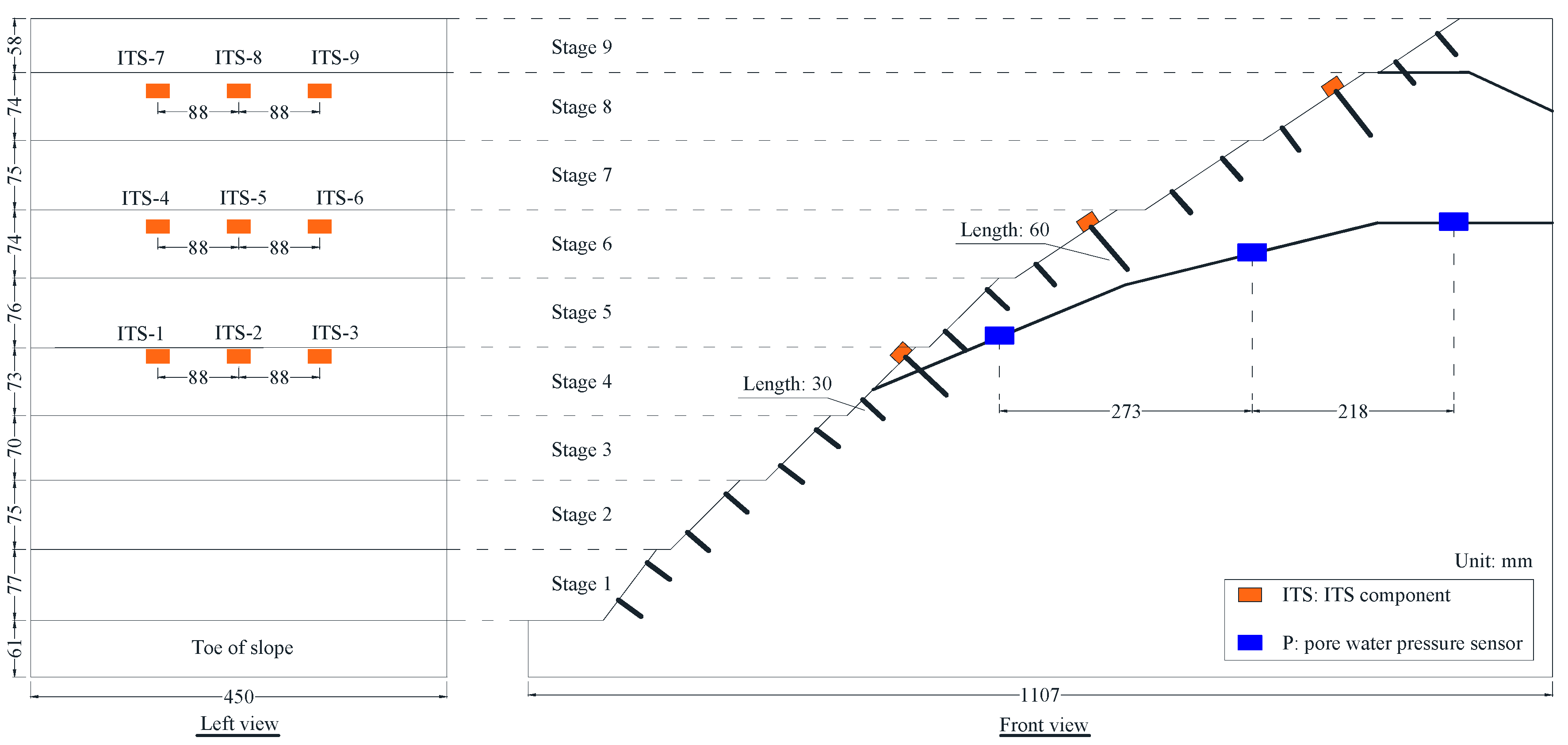
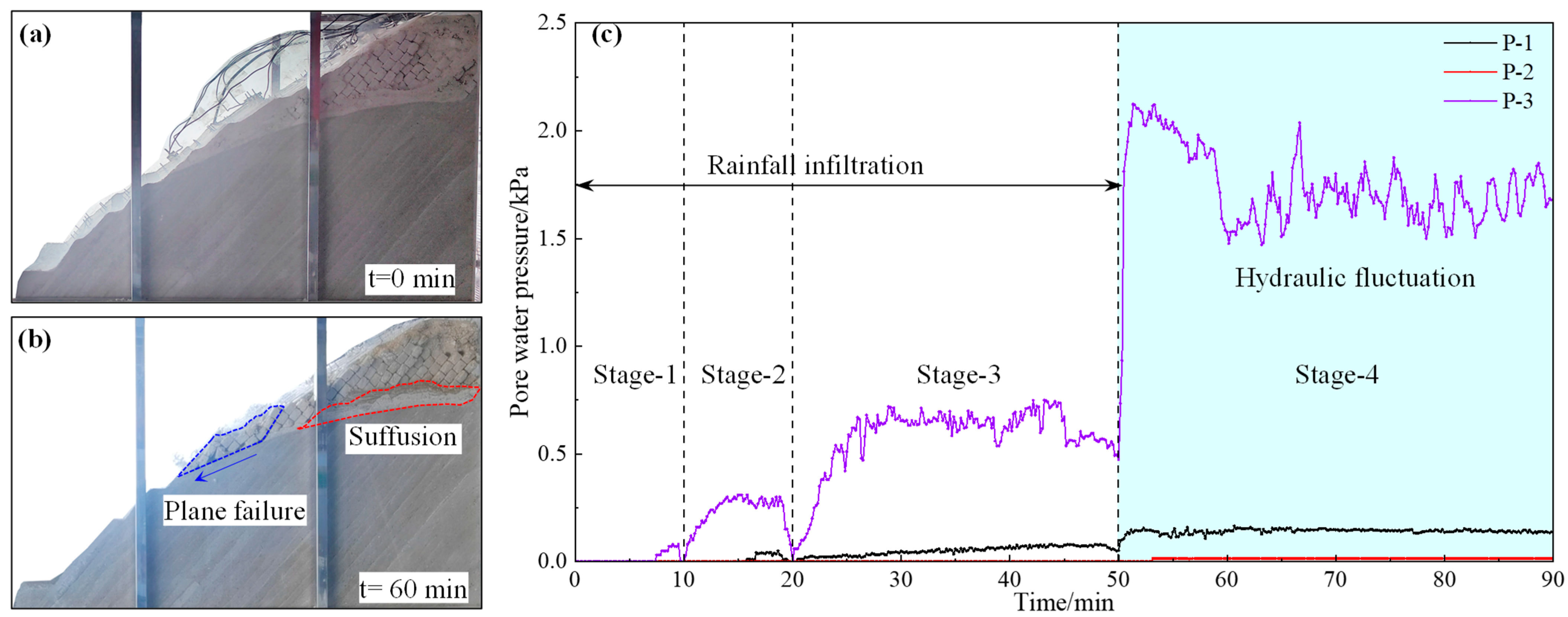
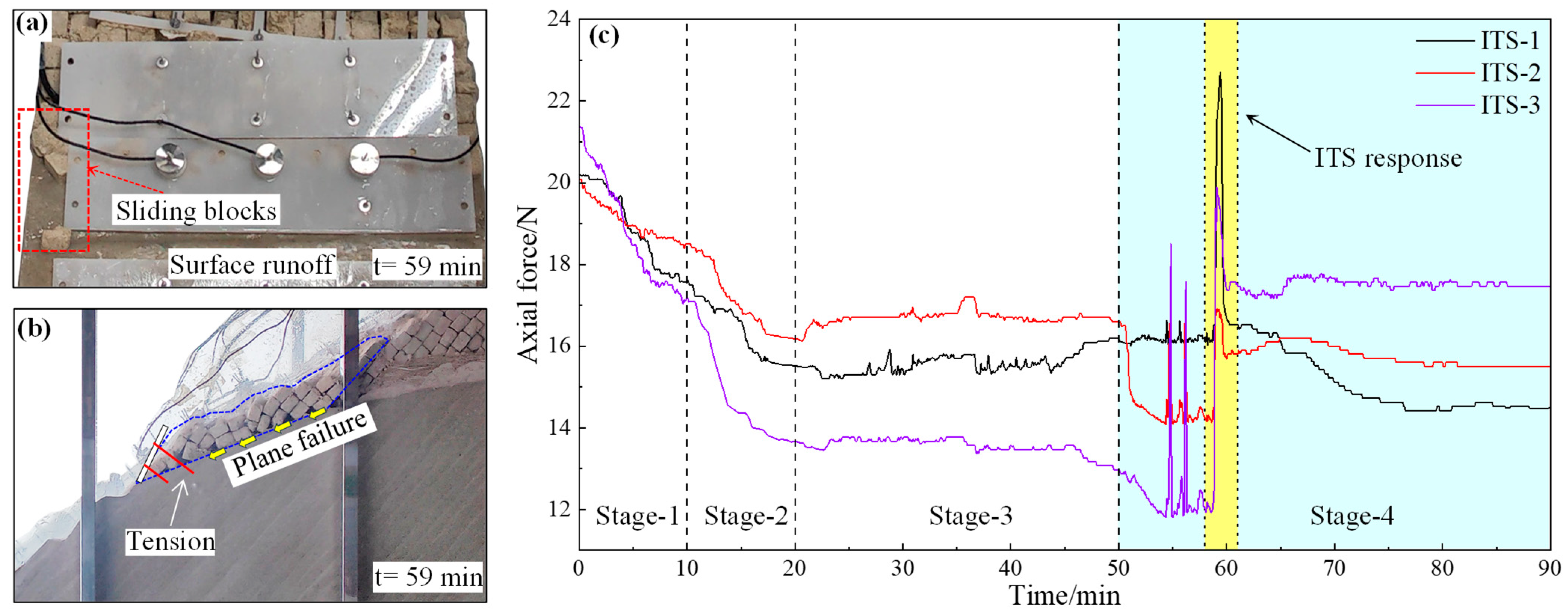
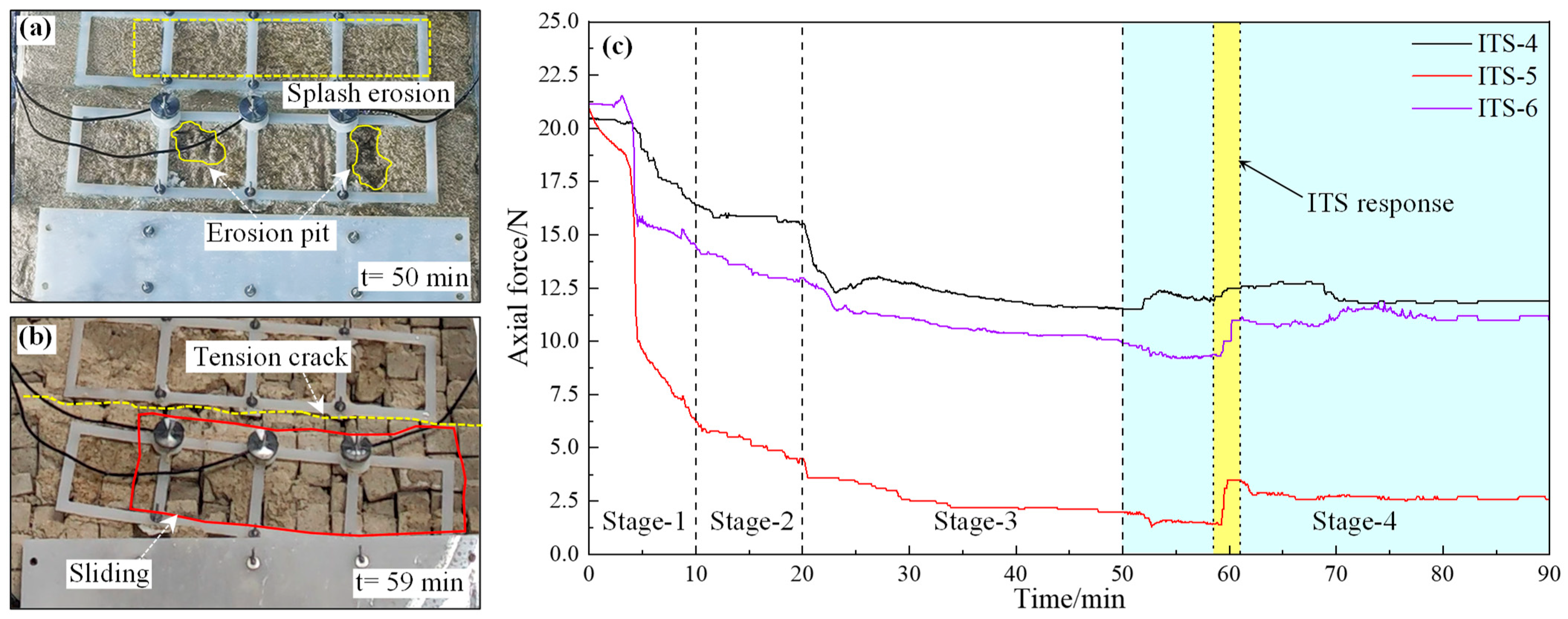
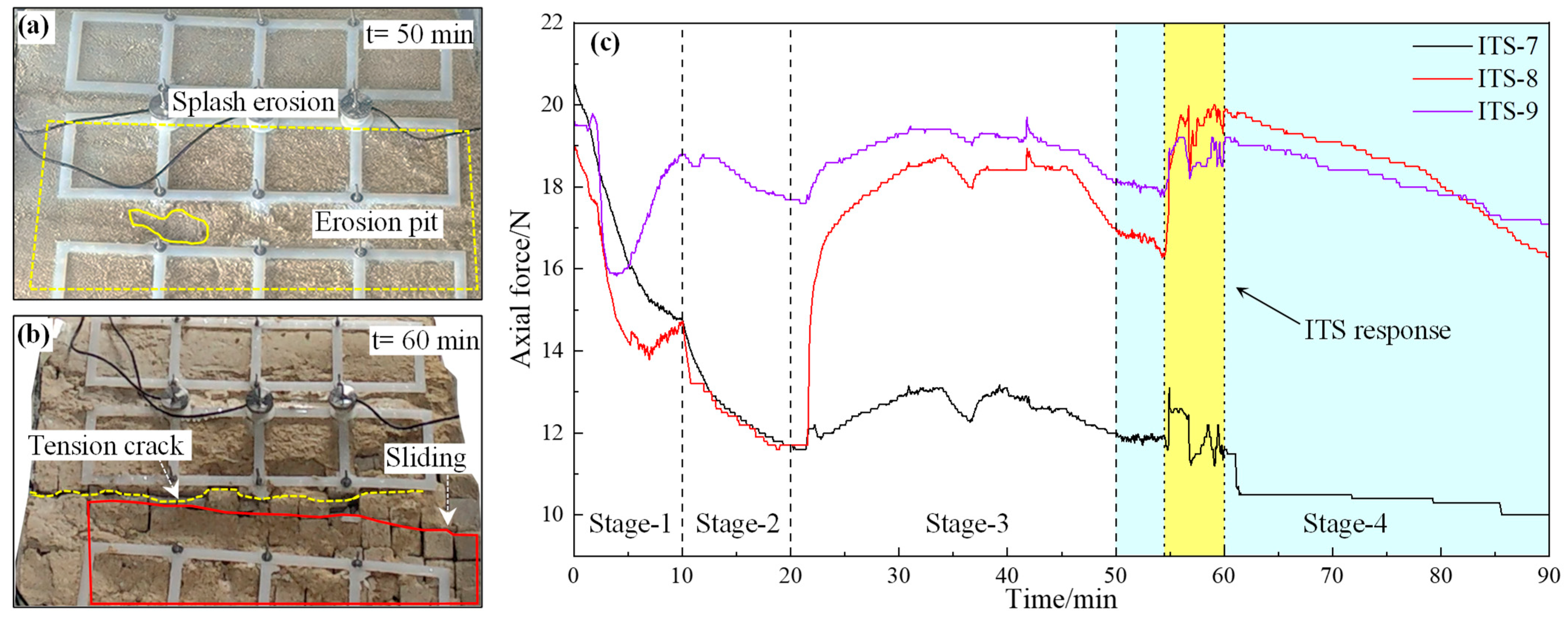
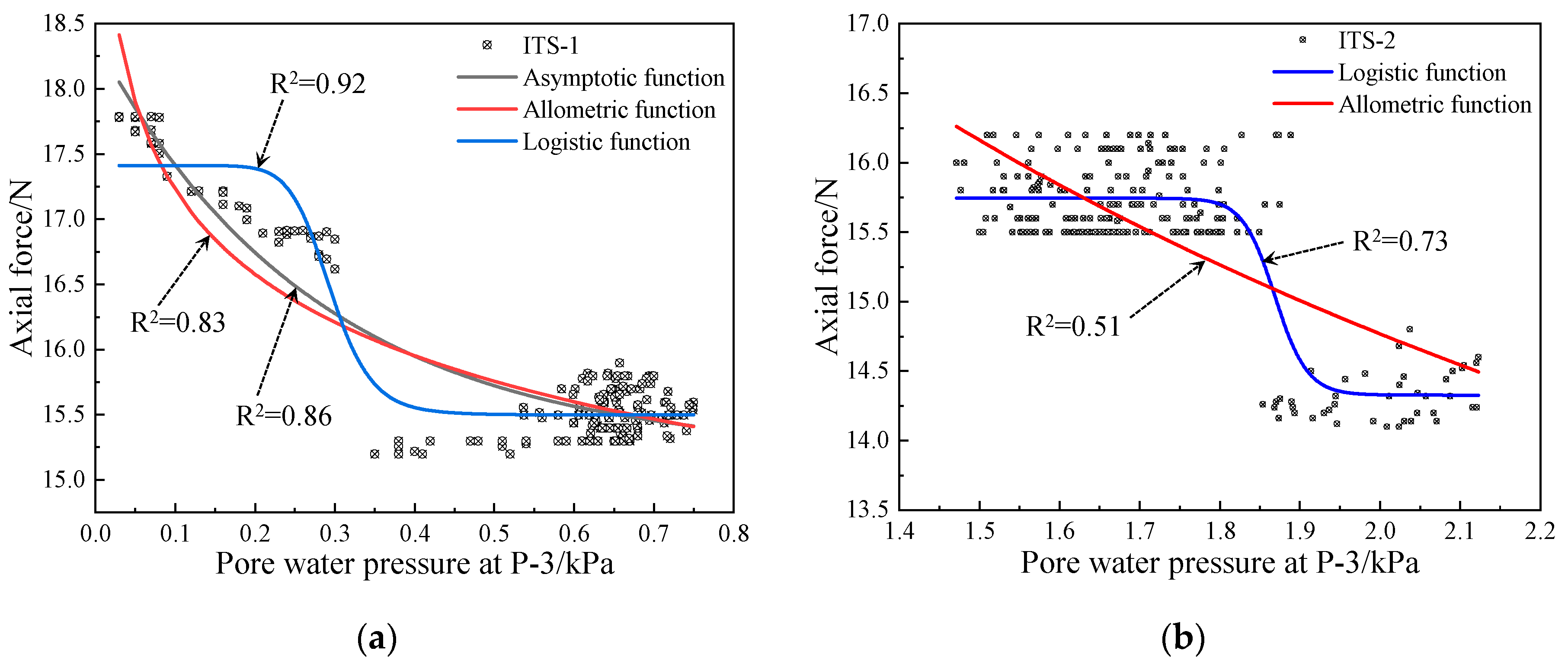
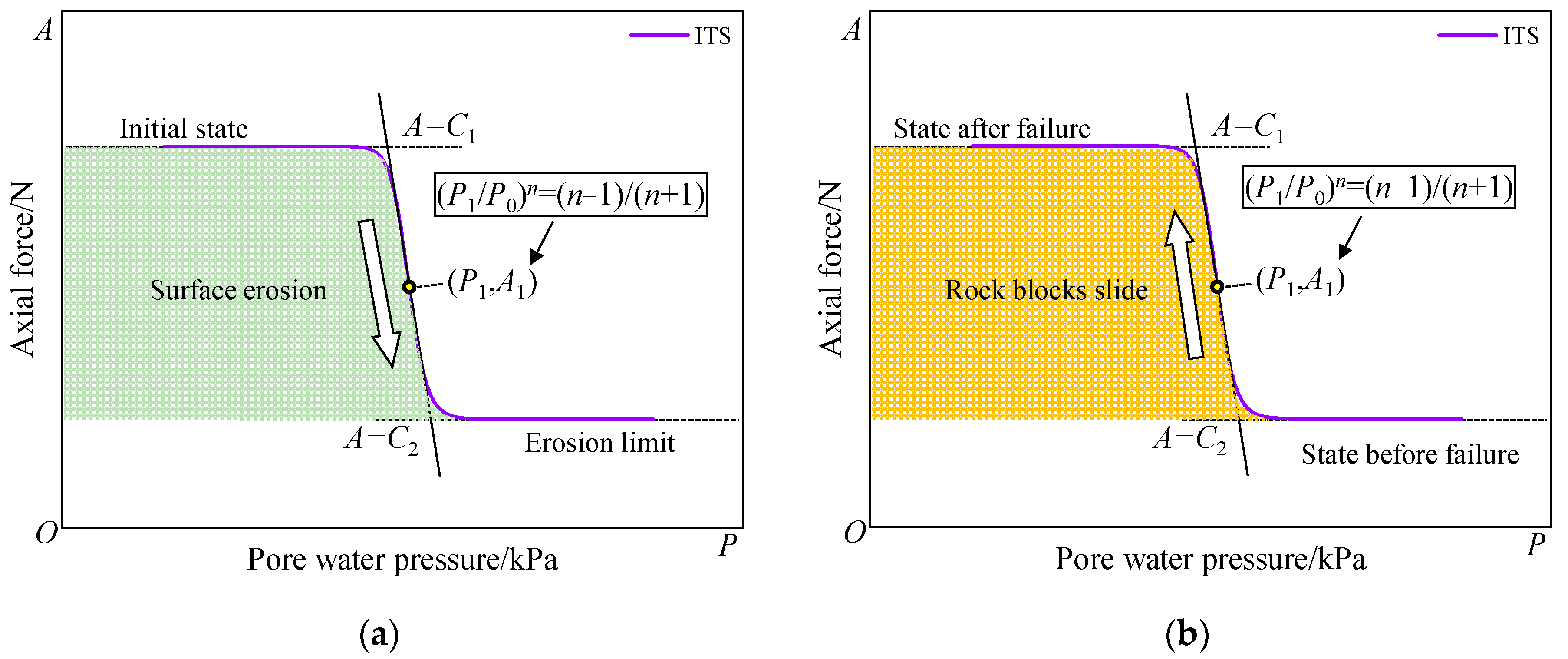

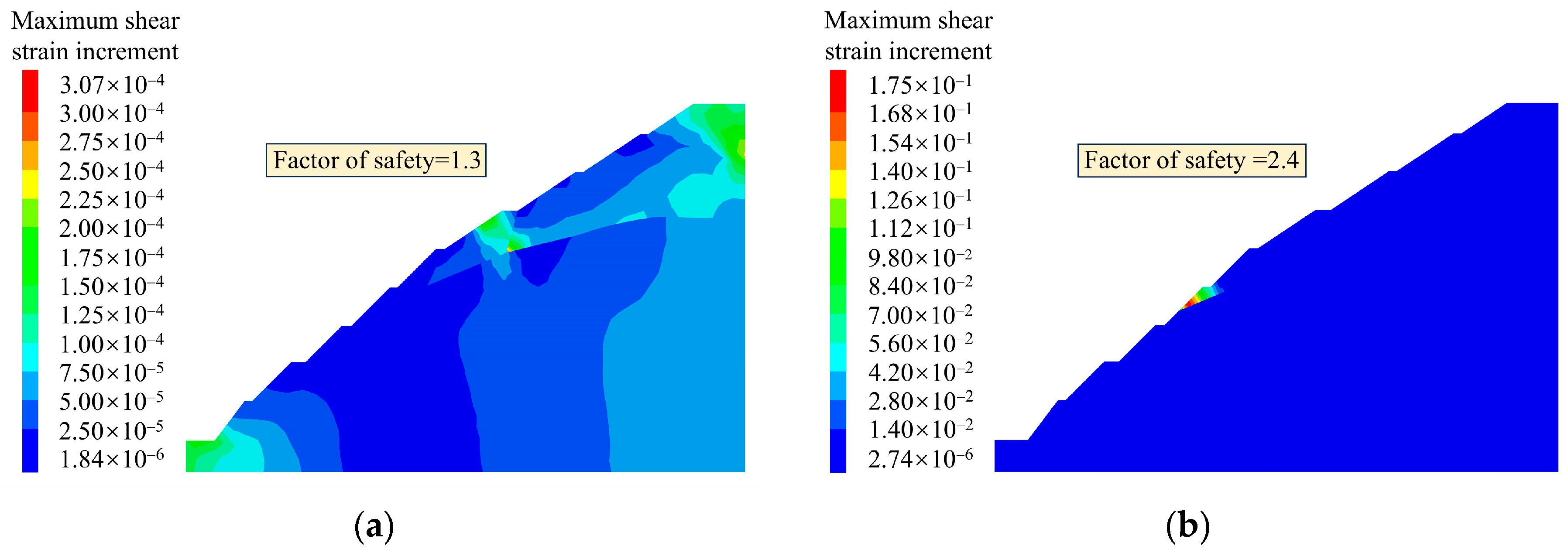
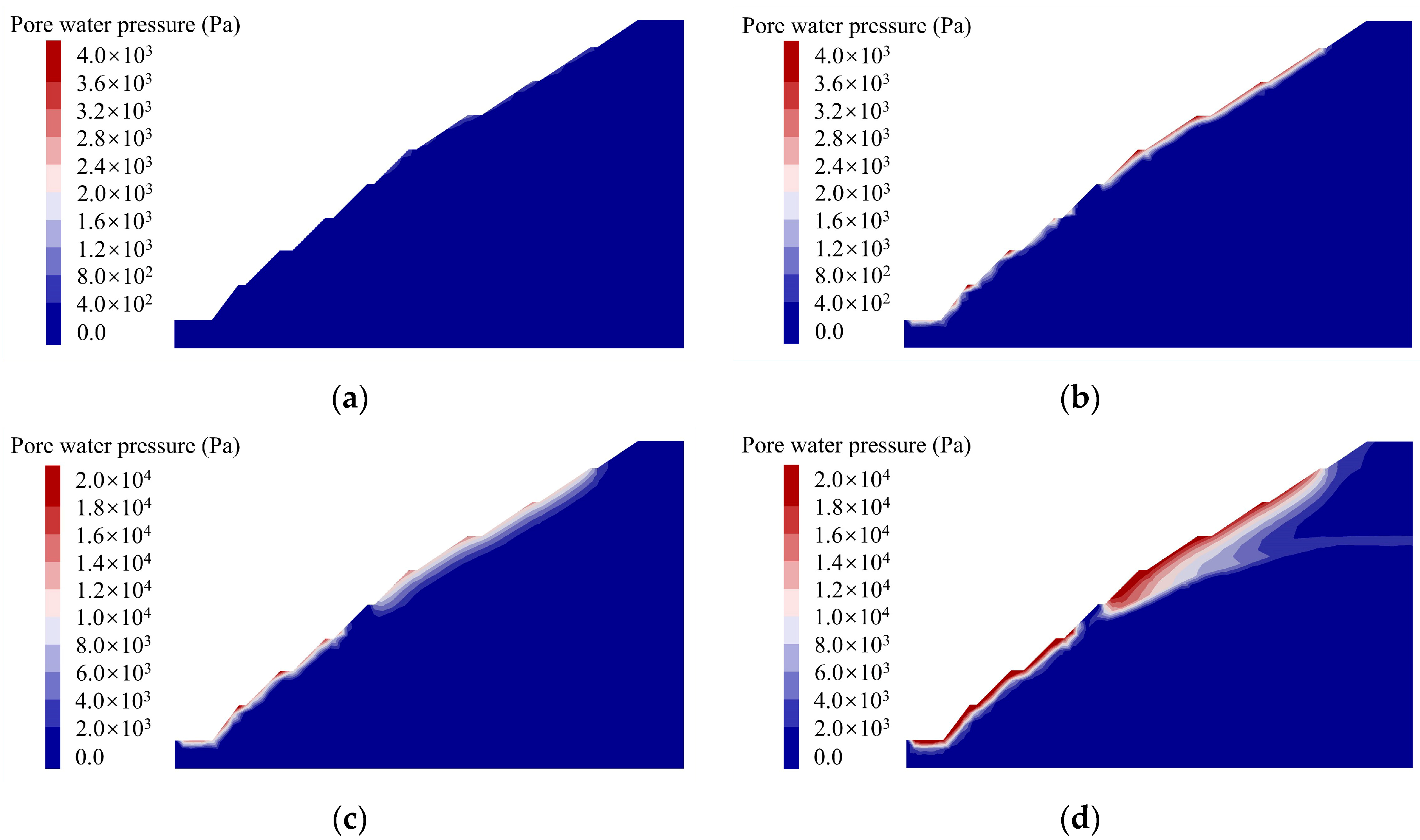
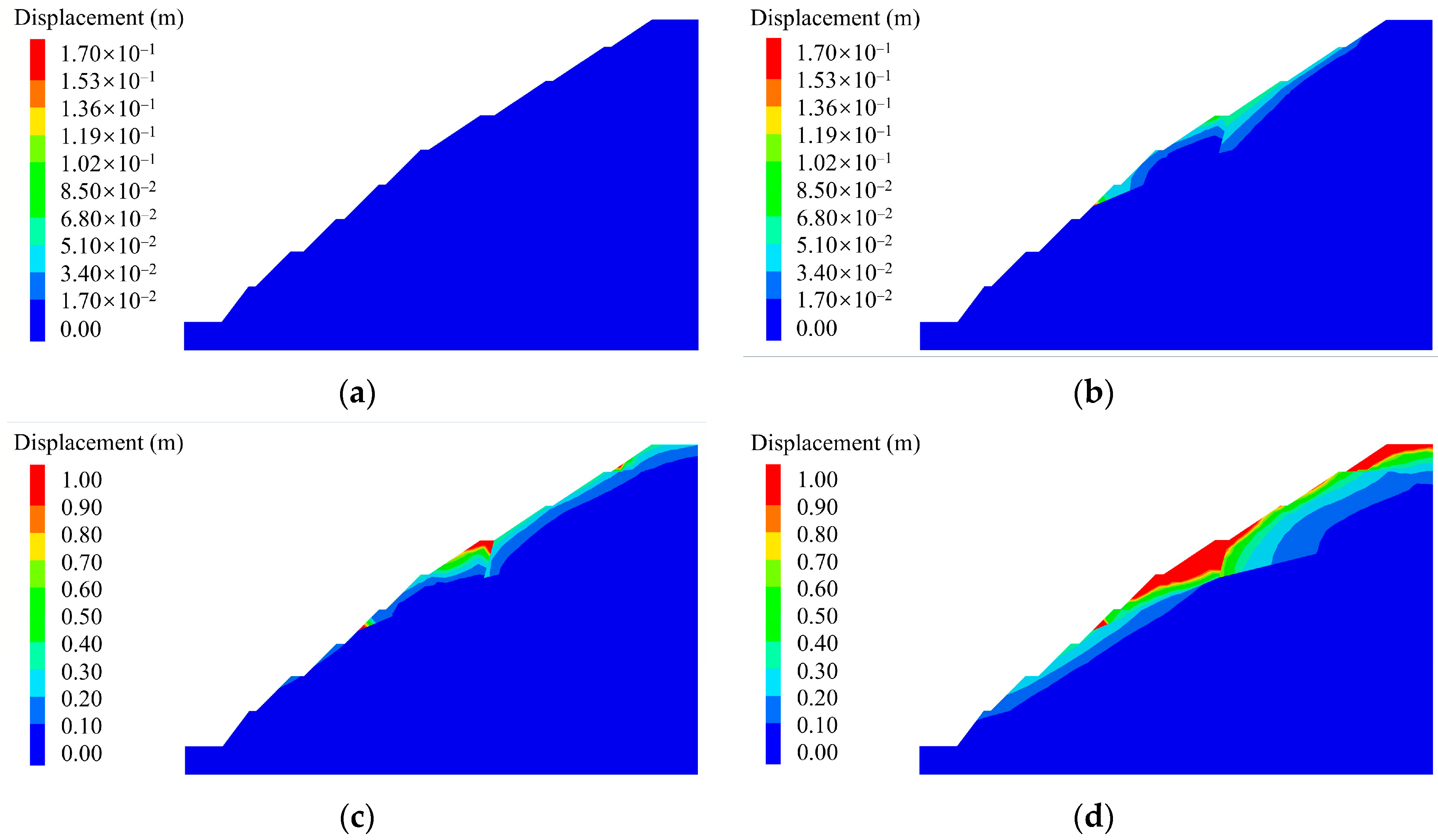
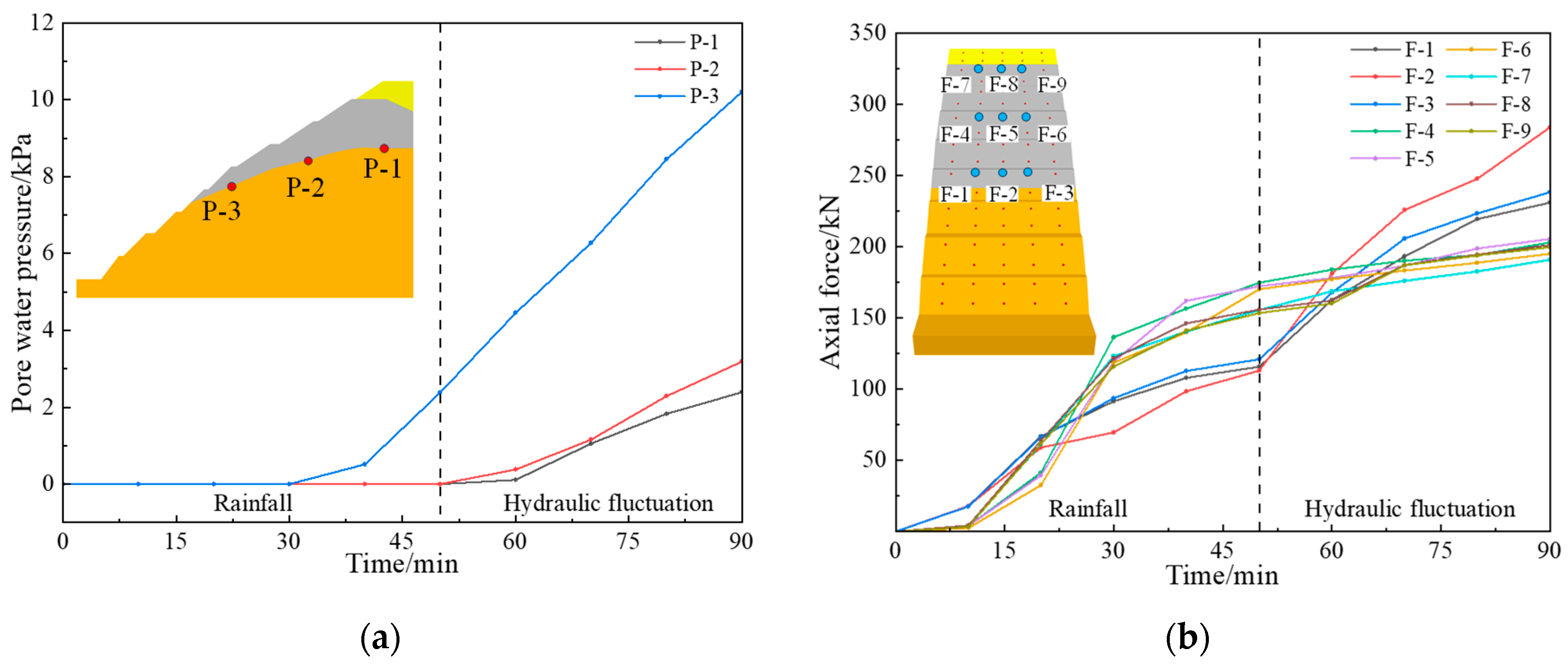
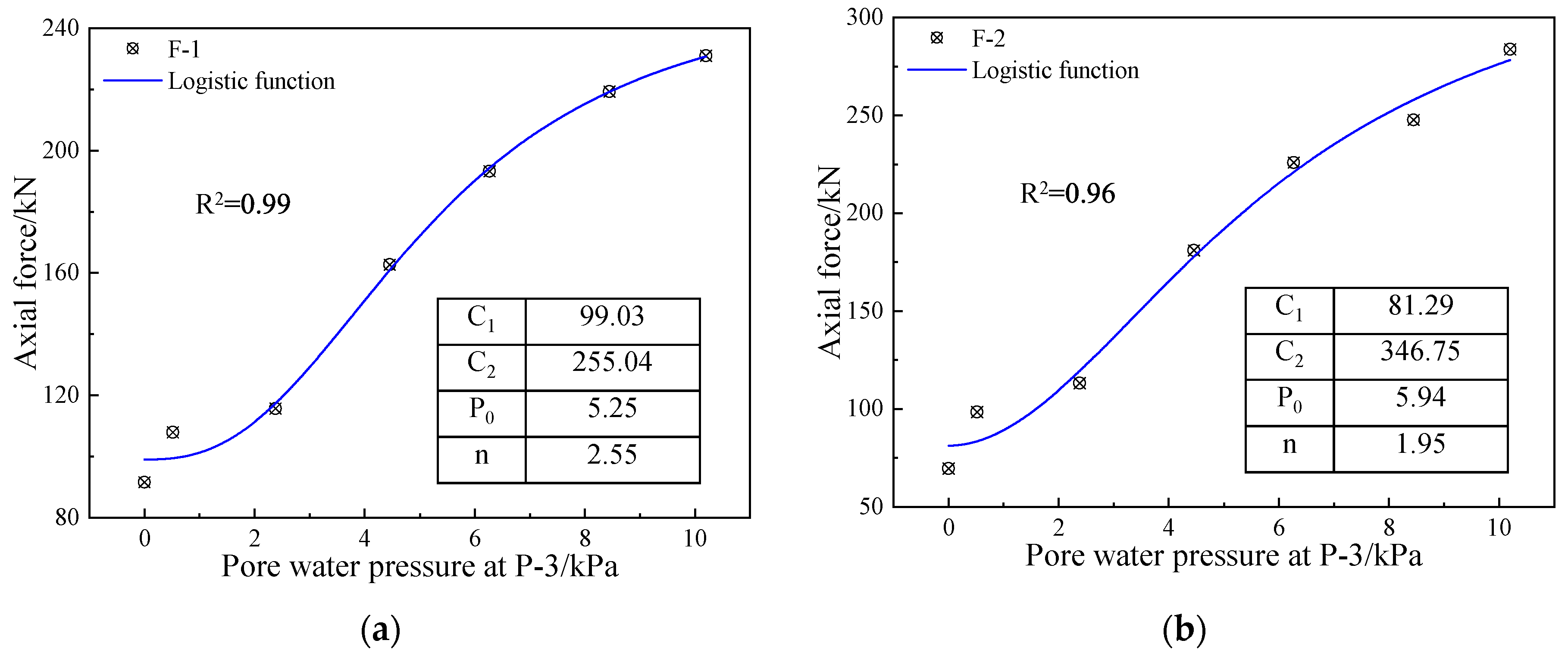
| Similarity Constant | Calculation Formula | Value |
|---|---|---|
| Stress σ | 260 | |
| Cohesion c | 260 | |
| Elastic module E | 260 | |
| Friction angle φ | 1 | |
| Time t | 14.1 | |
| Permeability coefficient k | 14.1 |
| Lithology | Uniaxial Compressive Strength (MPa) | E (MPa) | c (kPa) | (°) | () | |
|---|---|---|---|---|---|---|
| Weakly weathering rock | 90.00 | 4.00 × 104 | 2.5 × 103 | 45 | 2.50 | 1.00 × 10−7 |
| Strongly weathering rock | 45.00 | 1.00 × 104 | 9.0 × 103 | 35 | 2.40 | 2.00 × 10−6 |
| Fully weathering rock | N/A | N/A | 500.0 | 35 | 2.10 | 5.00 × 10−3 |
| Similarity material-1 | 0.37 | 143.61 | 121.5 | 46 | 1.93 | 2.53 × 10−8 |
| Similarity material-2 | 0.19 | 35.01 | 30.5 | 32 | 1.79 | 3.11 × 10−7 |
| Similarity material-3 | N/A | N/A | 6.6 | 34 | 1.66 | 8.13 × 10−4 |
| Material Name | Barite Powder (%) | Fine Sand (%) | Coarse Sand (%) | Gypsum (%) | Water (%) |
|---|---|---|---|---|---|
| Similarity material-1 | 30.9 | 43.6 | 8.7 | 7.1 | 9.7 |
| Similarity material-2 | 29.8 | 45.3 | 7.8 | 4.1 | 13.0 |
| Similarity material-3 | 20.1 | 57.7 | 8.1 | 0.7 | 13.4 |
| Loading Stage | Rainfall Intensity () | Wind Velocity () | Groundwater Device | Time (min) | |
|---|---|---|---|---|---|
| Rainfall infiltration | Stage-1 | 35 | 1 | off | 10 |
| Stage-2 | 65 | 3 | off | 10 | |
| Stage-3 | 105 | 5 | off | 30 | |
| Hydraulic fluctuation | Stage-4 | 105 | 5 | on | 40 |
| Variable | Constant | |||||
|---|---|---|---|---|---|---|
| A Data Set From | P Data Set From | n | ||||
| ITS-1 | P-3 | 17.41 | 15.50 | 0.29 | 11.34 | 0.92 |
| ITS-2 | P-3 | 18.51 | 16.72 | 0.24 | 7.81 | 0.95 |
| ITS-3 | P-3 | 17.34 | 13.56 | 0.22 | 4.40 | 0.99 |
| ITS-4 | P-3 | 16.43 | 12.27 | 0.32 | 17.38 | 0.93 |
| ITS-5 | P-3 | 7.18 | 0.33 | 0.42 | 1.82 | 0.94 |
| ITS-6 | P-3 | 14.72 | 10.37 | 0.34 | 3.76 | 0.94 |
| Variable | Constant | |||||
|---|---|---|---|---|---|---|
| A Data Set from | P Data Set from | n | ||||
| ITS-2 | P-3 | 15.74 | 14.33 | 1.87 | 92.35 | 0.73 |
| ITS-3 | P-3 | 17.51 | 12.18 | 1.87 | 115.41 | 0.89 |
| ITS-5 | P-3 | 2.74 | 1.59 | 1.86 | 115.94 | 0.76 |
| ITS-6 | P-3 | 11.09 | 9.43 | 1.87 | 148.25 | 0.78 |
| Name | () | E (MPa) | c (kPa) | (°) | v | n | |
|---|---|---|---|---|---|---|---|
| Fully weathering rock | 2100 | 800 | 500.0 | 35 | 0.30 | 0.25 | |
| Strongly weathering rock | 2400 | 35 | 0.26 | 0.1 | |||
| Weakly weathering rock | 2500 | 45 | 0.23 | 0.05 |
| Loading Stage | Rainfall Intensity () | Groundwater Discharge per Mesh () | Duration (min) | |
|---|---|---|---|---|
| Rainfall | Stage-1 | 35 | 0 | 10 |
| Stage-2 | 65 | 0 | 10 | |
| Stage-3 | 105 | 0 | 30 | |
| Hydraulic fluctuation | Stage-4 | 105 | 40 | |
| Variable | Constant | |||||
|---|---|---|---|---|---|---|
| A Data Set From | P Data Set From | n | ||||
| F-3 | P-3 | 102.85 | 255.55 | 4.94 | 2.71 | 0.98 |
| F-4 | P-3 | 136.32 | 1035.87 | 6018.94 | 0.40 | 0.99 |
| F-6 | P-3 | 118.38 | 216.52 | 2.42 | 0.79 | 0.99 |
| F-8 | P-3 | 124.57 | 6.08 | 0.57 | 0.92 | |
Disclaimer/Publisher’s Note: The statements, opinions and data contained in all publications are solely those of the individual author(s) and contributor(s) and not of MDPI and/or the editor(s). MDPI and/or the editor(s) disclaim responsibility for any injury to people or property resulting from any ideas, methods, instructions or products referred to in the content. |
© 2025 by the authors. Licensee MDPI, Basel, Switzerland. This article is an open access article distributed under the terms and conditions of the Creative Commons Attribution (CC BY) license (https://creativecommons.org/licenses/by/4.0/).
Share and Cite
Fan, Q.; Sun, H.; Meng, Z.; Wang, Y. Stability Monitoring and Numerical Simulation of Weathering Transition Zones in Dam Slopes of Tropical Islands. Appl. Sci. 2025, 15, 4499. https://doi.org/10.3390/app15084499
Fan Q, Sun H, Meng Z, Wang Y. Stability Monitoring and Numerical Simulation of Weathering Transition Zones in Dam Slopes of Tropical Islands. Applied Sciences. 2025; 15(8):4499. https://doi.org/10.3390/app15084499
Chicago/Turabian StyleFan, Qiaofeng, Huan Sun, Zimin Meng, and Yongkang Wang. 2025. "Stability Monitoring and Numerical Simulation of Weathering Transition Zones in Dam Slopes of Tropical Islands" Applied Sciences 15, no. 8: 4499. https://doi.org/10.3390/app15084499
APA StyleFan, Q., Sun, H., Meng, Z., & Wang, Y. (2025). Stability Monitoring and Numerical Simulation of Weathering Transition Zones in Dam Slopes of Tropical Islands. Applied Sciences, 15(8), 4499. https://doi.org/10.3390/app15084499





